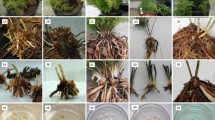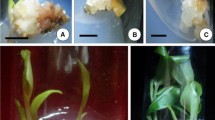Abstract
Cultivated asparagus (Asparagus officinalis L.) is an economically important plant worldwide. “Morado de Huetor” is a Spanish autochthonous landrace characterized by their longevity, organoleptic characteristics, differential biocompound content and high heterozygosity, resulting in heterogeneous plantations with limited productivity. Consequently, this landrace suffers high risk of extinction due the lack of productivity. The preservation of the genetic pool of asparagus requires the development of a reliable micropropagation method. A new, rapid and efficient method of micropropagation for asparagus using rhizome bud explants has been developed. The rate of disinfection reached 90 %, and the system for shoot development and rooting on Asparagus Rhizome Bud Medium took place in one step. Recovery of the full plantlets ranged between 65 and 90 %. The plantlets were ready to be transplanted by 8 weeks, with a successful acclimatization of 80 % in average. The micropropagated plants were normal in phenotype, and the genetic stability was verified using molecular markers expressed sequence tags–microsatellites or simple sequence repeats and Flow Cytometry and certified as true-to-type. Applying this method, an in vitro breeder collection of “Morado de Huetor” landrace, A. officinalis, wild asparagus relatives and hybrid progenies has been established.



Similar content being viewed by others
Abbreviations
- AFLP:
-
Amplified fragment length polymorphism
- ANC:
-
Ancymidol
- ARBM:
-
Asparagus rhizome bud medium
- DAM:
-
Desjardins Asparagus medium
- EDDHA:
-
Ethylenediamine-N,N′-bis(2-hydroxyphenylacetic acid)
- EST:
-
Expressed sequence tags
- FCM:
-
Flow cytometry
- KIN:
-
Kinetin
- MS:
-
Murashige and Skoog medium (1962)
- NAA:
-
1-Naphthalene-acetic acid
- RAPD:
-
Random amplified polymorphic DNA
- SSRs:
-
Microsatellites or simple sequence repeats
- 2iP:
-
2-Isopentenil adenine
- BA:
-
6-Benziladenine
- IBA:
-
Indole-3-butyric acid
- IAA:
-
Indole-3-acetic acid
- bp:
-
Base pairs
References
Araki H, Shimazaki H, Hirata Y, Oridate T, Harada T, Yakuwa T (1992) Chromosome number variation of callus cells and regenerated plants in Asparagus officinalis L. Plant Tis Cult Lett 9:169–175
Bairu MW, Aremu AO, Van Staden J (2011) Somaclonal variation in plants: causes and detection methods. Plant Growth Regul 63:147–173
Cao H, Biswas MK, Lü Y, Amar MH, Tong Z, Xu Q, Xu H, Guo W, Deng X (2011) Doubled haploid callus lines of Valencia sweet orange recovered from anther culture. Plant Cell Tiss Organ Cult 104:415–423
Caruso M, Federici CT, Roose ML (2008) EST-SSR markers for asparagus genetic diversity evaluation and cultivar identification. Mol Breeding 21:195–204. doi:10.1007/s11032-007-9120-z
Chin CK (1982) Promotion of shoot and root formation in asparagus in vitro by ancymidol. HortScience 17:590–591
Christensen B, Sriskandarajh S, Serek M, Müller R (2008) In vitro culture of Hibiscus rosa-sinensis L.: influence of iron, calcium and BAP on establishment and multiplication. Plant Cell Tiss Organ Cult 93:151–161
Desjardins Y (1992) Micropropagation of Asparagus (Asparagus officinalis L.). In: Bajaj YPS (ed) Biotechnology in agriculture and forestry. Vol. 19: high-tech and micropropagation III. Springer, Berlin-Heidelberg, pp 26–41
Desjardins Y, Tiessen H, Harney PM (1987) The effect of sucrose and ancymidol on the in vitro rooting of nodal sections of asparagus. Hort Science 22:131–133
Escobedo-GraciaMedrano RM, Maldonado-Borges JI, Burgos-Tan MJ, Valadez-González N, Ku-Cauich JR (2014) Using flow cytometry and cytological analyses to assess the genetic stability of somatic embryo-derived plantlets from embryogenic Musa acuminata Colla (AA) P. malaccensis cell suspension cultures. Plant Cell Tiss Organ Cult 116:175–185
Galbraight DW, Harkins KR, Maddox JM, Ayres NM, Sharma DP, Firoozabady E (1983) Rapid flow cytometric analysis of the cell cycle in intact plant tissues. Science 220:1049–1051
Galbraight DW, Lambert G, Macas J, Dolezel J (2002) Analysis of nuclear DNA content and ploidy in higher plants. In Robinson J, Darzynkiewicz Z, Dean P, Hibbs A, Orfao A, Rabinovitch P, Wheeless L (ed) Current Protocols in Cytometry. John Wiley and Sons: New York, pp 7.6.1–7.6.22. doi: 10.1002/0471142956.cy0706s02
Gao DY, Vallejo V, He B, Gai YC, Sun LH (2009) Detection of DNA changes in somaclonal mutants of rice using SSR markers and transposon display. Plant Cell Tiss Organ Cult 98:187–196
Geoffriau E, Denoue D, Remeau C (1992) Assessment of genetic variation among asparagus (Asparagus officinalis L.) populations and cultivars: agromorphological and isozymic data. Euphytica 61:169–179
Hasegawa PM, Murashige T, Takatori FH (1973) Propagation of asparagus through shoot apex culture II. Light and temperature requirements, transplantability of plants, and cyto-histological characteristics. J Am Soc Hort Sci 98:143–148
Idris TIM, Ujool SAM, Mahdi EM (2010) Disinfection potential of some chemicals and local herbs and proliferation studies on the in vitro culture of ginger (Zingiber officinale Rosc). J Sci Tech 11:34–39
Knaflewsky M (1996) Genealogy of asparagus cultivars. In: Nichols M, Swain D (ed). Proceedings VIII Int Asparagus Symp. pp 87–91
Kohmura H, Ito T, Shigemoto N, Imoto M, Yoshikawa H (1996) Comparison of growth, yield, and flowering characteristics between micropropagated asparagus clones derived by somatic embryogenesis and seed-propagated progenies. J Jpn Soc Hort Sci 65:311–319
Kunitake H, Nakashima T, Mori K, Tanaka M (1998) Somaclonal and chromosomal effects of genotype, ploidy and culture duration in Asparagus officinalis L. Euphytica 102:309–316
Limanton-Grevet A, Sotta B, Brown S, Jullien M (2000) Analysis of habituated embryogenic lines in Asparagus officinalis L.: growth characteristics, hormone content and Ploidy level of calli and regenerated plants. Plant Sci 160:15–26
Littell RC, Stroup WW, Freund R (2002) SAS for linear models, 4th edn. SAS Institute Inc, Cary
Liu F, Huang LL, Li YL, Reinhoud P, Jongsma MA, Wang CY (2011) Shoot organogenesis in leaf explants of Hydrangea macrophylla ‘Hyd1’ and assessing genetic stability of regenerants using ISSR markers. Plant Cell Tiss Organ Cult 104:111–117
Moreno R, Espejo JA, Cabrera A, Millan T, Gil J (2006) Ploidic and molecular analysis of ‘Morado de Huetor’ Asparagus (Asparagus officinalis L.) population: a Spanish tetraploid landrace. Genet Resour Crop Ev 53:729–736. doi:10.1007/s10722-004-4717-0
Moreno R, Espejo JA, Cabrera A, Gil J (2008a) Origin of tetraploid cultivated asparagus landraces inferred from nrDNA ITS polymorphisms. Ann Appl Biol 153:233–241. doi:10.1111/j.1744-348.2008.00254.x
Moreno R, Espejo JA, Moreno MT, Gil J (2008b) Collection and conservation of ‘Morado de Huetor’ Spanish tetraploid asparagus landrace. Genet Resour Crop Ev 55:773–777. doi:10.1007/s10722-008-9358-2
Moreno R, Carmona E, Encina CL, Rubio J, Gil J (2010a) Aplicación de marcadores microsatélites en la mejora del espárrago. Actas Hortic 55:221–222
Moreno R, Espejo JA, Gil J (2010b) Development of triploid hybrids in asparagus breeding employing a tetraploid landrace. Euphytica 173:369–375. doi:10.1007/s10681-009-0103-5
Murashige T, Skoog F (1962) A revised medium for rapid growth and bioassays with tobacco tissue culture. Physiol Plant 15:473–497
Murashige T, Shabde MN, Hasegawa PM, Takatori FH, Jones JB (1972) Propagation of asparagus through shoot apex culture. J Am Soc Hort Sci 97:158–161
Ochatt SJ, Patat-Ochatt EM, Moessner A (2011) Ploidy level determination within the context of in vitro breeding. Plant Cell Tiss Organ Cult 104:329–341
Ochatt S, Jacas L, Patat-Ochatt EM, Djenanne S (2013) Flow cytometric analysis and molecular characterization of Agrobacterium tumefaciens-mediated transformants of Medicago truncatula. Plant Cell Tiss Organ Cult 113:237–244
Odake Y, Udagawa A, Saga H, Mii M (1993) Somatic embryogenesis of tetraploid plants from internodal segments of a diploid cultivar of Asparagus officinalis L. grown in liquid culture. Plant Sci 94:173–177
Pontaroli AC, Camadro EL (2005) Somaclonal variation in Asparagus officinalis L. plants regenerated by organogenesis from long-term callus cultures. Genet Mol Biol 28:423–430
Raimondi JP, Camadro EL, Masuelli RW (2001) Assessment of somaclonal variation in asparagus by RAPD fingerprinting and cytogenetic analyses. Sci Hortic 90:19–29
Shiga I, Uno Y, Kanechi M, Inagaki N (2009) Identification of polyploidy of in vitro anther-derived shoots of Asparagus officinalis L. by flow cytometric analysis and measurement of stomatal length. J Japan Soc Hort SCI 78(1):103–108
Torres AM, Weeden NF, Martin A (1993) Linkage among isozyme, RFLP and RAPD markers in Vicia Faba. Theor Appl Genet 85:935–945
Vujovic T, Cerovic R, Ruzic D (2012) Ploidy level stability of adventitious shoots of sour cherry ‘Čacanski Rubin’ and Gisela 5 cherry rootstock. Plant Cell Tiss Organ Cult 111:323–333
Yang HJ, Clore WJ (1973) Rapid propagation of asparagus through lateral bud culture. HortScience 8:141–143
Yang HJ, Clore WJ (1974) Development of complete plantlets from moderately vigorous shoot of stocks plants of asparagus in vitro. HortScience 9:138–139
Yukimasa H, Shigeru T, Rie M, Atsuko K (1990) Patent: Method of multiplying plant belonging to the genus asparagus. Patent No: EP0375218. Assignee: Mitsui Petrochemical Ind (JP). Application No: EP19890312806 19891208
Author information
Authors and Affiliations
Corresponding author
Rights and permissions
About this article
Cite this article
Carmona-Martín, E., Regalado, J.J., Padilla, I.M.G. et al. A new and efficient micropropagation method and its breeding applications in Asparagus genera. Plant Cell Tiss Organ Cult 119, 479–488 (2014). https://doi.org/10.1007/s11240-014-0548-7
Received:
Accepted:
Published:
Issue Date:
DOI: https://doi.org/10.1007/s11240-014-0548-7




